Australia is the only place on Earth where Opalized Animal fossils can be found. If you haven’t heard of Opal then you might have been living under a rock. This gemstone is also a key to Australia’s mysterious past because dinosaur fossils and various other creatures that lived over 110 million years ago are buried in the Australian Opal fields. It was during the Early Cretaceous times that these plants and animals roamed about the planet.
Opalized fossils are incredibly rare and precious because for these gemstones to occur you need a fossil and Opal to come together at the right time to make this amazing specimen. Over the years miners have discovered bones, shells, and even pinecones that have turned into solid Opal! While Opals can be found in different regions of the world, Australia produces about 95% of them.
How Do Opalized Fossils Form?
Opal naturally forms in the cavities of rocks. Suppose the cavity is present because a part of a living thing (bone, shells, teeth, pinecones) was buried in the clay or sand before it turned to stone. In that case, Opal can form a fossil replica of whatever it once was.
Fossils are simply the traces or remains of ancient plants or animals preserved in rock. Opalized fossils form similarly to other fossils, except for the fact that they’re preserved in silica. Fossils that are not Opalized are preserved in minerals like Limestone, Agate, or Pyrite. The sediments that buried the animal or plant remains in the Opal fields were silica-rich because of the ancient volcanoes.
The Opalization of animals and plants occurs in two ways, and they may become so in a combination of the two processes.
- Internal Details Not Preserved: these are referred to as Jelly Mold Fossils. Opal starts as silica that’s dissolved in water. When silica solution fills the empty cavities left by a bone or shell that’s rotted away it can harden, forming an Opalized cast of the original item. These fossils have exterior features that are beautifully preserved, but they lack internal structure, so it’s not imprisoned or recorded.
- Internal Details Preserved: When silica seeps into the organic material before decomposition occurs, the organic molecules can be replaced by silica. In turn, it preserves all of the fine details of the structures inside the plants or bones.
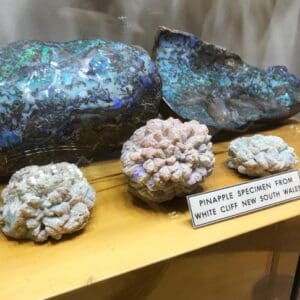
How Rare Are Opalized Fossils?
Opalized fossils are incredibly precious and rare. Aside from the fact that they’re only found in Australia, it’s rare to find fossils of any sort from the time of the dinosaurs.
During the Cretaceous period, there was a shallow inland sea, the Eromanga Sea, that covered nearly a third of the country. Rivers and streams flowed into saltwater estuaries while evergreen forests blanketed the floodplains.
Some Opal fields, including Cobber Pedy and White Cliffs, primarily produce marine animals and plant fossils. While at Lightening Ridge, a majority of the Opalized fossils are freshwater species, plants, and animals.
All the Opalized fossils found in the country are considered national treasures. The National Opal Collection is an entire treasure trove of beautiful, rare Opalized fossils and specimens.
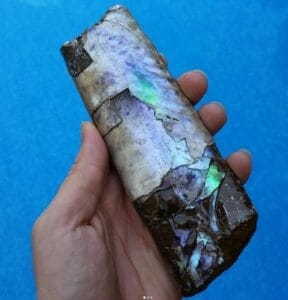
Opalized Bone
It’s not only Opal that can be found in Australia, but bones, teeth, plants, and shells were embedded in the ancient claystone. They became preserved like beautiful gemstones, hiding away for 100 million years under the thin veneer of sediment. There is a variety of various animal bones that have been found Opalized, and the specimens are incredible.
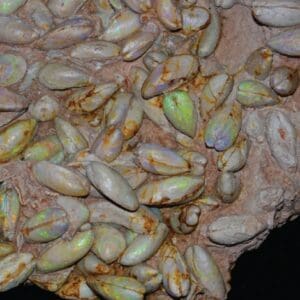
Opalized Clam Fossils
Gastropod and bivalve mollusks like mussels, snails, and clams are among the most commonly found Opalized fossils at Australia’s Lightning Ridge. These freshwater species significantly differ from those found at White Cliffs and in southern Australia. This is because they lived in a marine environment as opposed to freshwater.
Some mines intersect with paleochannels that can sometimes contain rich deposits of bivalve mollusks. Occasionally, there are concentrations of whelks that form dense death assemblages within the sandstone.
Many species of Opalized mollusks have been found at Lightning Ridge. While some of them are relatively common, others are incredibly rare.
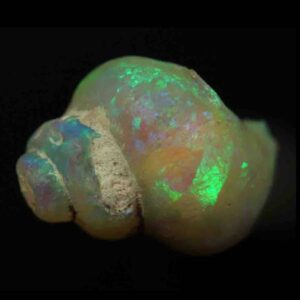
Opalized Shells
Opalized shells occur when Opal sets in the shells, which then dissolves over time. This event leaves the shell’s imprint behind, which are commonly referred to as jelly Mold Fossils.
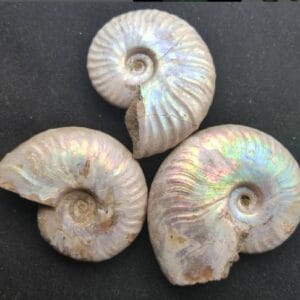
Opalized Dinosaur Fossils
Eric the Plesiosaur is incredibly popular around the world, not only in Australia.
During the natural fossilization process, Opalazition took place, leaving behind a fossil with semi-precious hues of Opal colors. Eric was discovered in 1987 by Opal miners in Coober Pedy, South Australia. Plesiosaurs are not dinosaurs; they’re actually marine reptiles. That said, Eric is a marine reptile, not a dinosaur. But the locals call him a dinosaur.
However, in 2018 an Opalized jaw bone of a newly discovered dog-sized dinosaur was discovered! I’m sure there’s much more where that came from.
- Identify Enstatite - March 12, 2024
- Identify Cerussite - March 3, 2024
- Identify Bytownite - February 18, 2024
